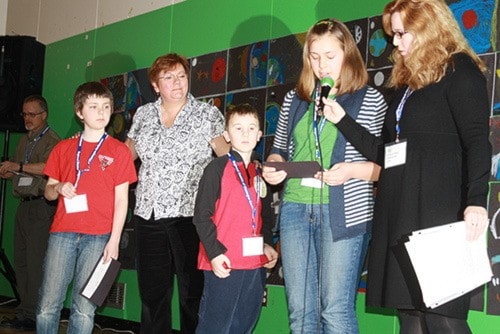Five hundred of the region’s elementary school students had an experience that was out of this world on Friday, February 22 at Uplands School in Penticton.
Two grade six classes from Similkameen Elementary Secondary School attended an assembly in which 20 students asked orbiting Canadian astronaut Chris Hadfield questions about life in space. Two students from Keremeos, Naomi Antler and Missy Vesper, were among those whose questions were put forward to the astronaut.
The outer space contact came about as part of the Amateur Radio on the International Space Station (ARISS) program, a volunteer initiative aimed at inspiring students worldwide to pursue careers in science, technology, engineering and math through amateur radio communications opportunities.
Members of the local ham (amateur) radio fraternity were on hand to explain the part their hobby played in the event. Orin Beebe, a resident of Upper Bench Road, has been a ham radio operator since his 15th birthday.
“I was once the youngest person in Canada ever to have a ham radio license, and if I live long enough, I’ll be the oldest,” Beebe laughed, describing his experiences with amateur radio to be some of the most rewarding in his life.
Penticton amatuer radio operator Allan Stark noted that there are 200 amateur operators in the region, and 500 Okanagan valley wide.
“Amateur radio operators are often the only communication available after a major natural disaster,” he said, adding that ham operators can listen to International Space Station communications when tuned to their frequency - 145.800 - whenever astronauts operate the amateur radio on board the space station.
Amateur radio played an integral part in the event. A phone patch from Uplands School was set up with an amateur radio operator in northwest Italy, who used his ham radio setup to communicate with the International Space Station. Hadfield was travelling 350 kilometres overhead, at 23,000 kilometres per hour, leaving a roughly ten minute window for communication between Uplands and the ISS.
Anticipation was palpable amongst the 500 plus students, media, local politicians, reserves, emergency service staff, and parents crammed into the school gymnasium as Hadfield approached the radio transmission zone of the Italian ham operator. At first faint and garbled, the transmission grew distinct as Hadfield travelled overhead.
The students had time to answer 20 of 23 pre-written questions. Hadfield was able to tell them the most beautiful spot on the planet as seen from space -”I’d like to tell you Penticton, but I think the Bahamas, with their coral reefs, are the most beautiful,” he answered.
Students also asked about playing the guitar - “it sounds the same as on Earth, but more difficult to play because of the weightlessness” - about failing - “I’ve made small mistakes, but through hard work I’ve avoided making big ones.”
The students had several other interesting topics that Hadfield was able to educate them on before his signal began to fade. Italian ham radio operator Claudio Ariottli provided the Italian link for the conversation, while Brian Edge provided coordinationfor the effort in Penticton. Italy was selected because of its proximity to the ISS to Earth in its orbit at 11:36 local time (19:36 UTC).
The International Space Station can be currently be seen in the Similkameen sky at 6:04 p.m., appearing in the southwest sky and moving in an east- north east direction.
